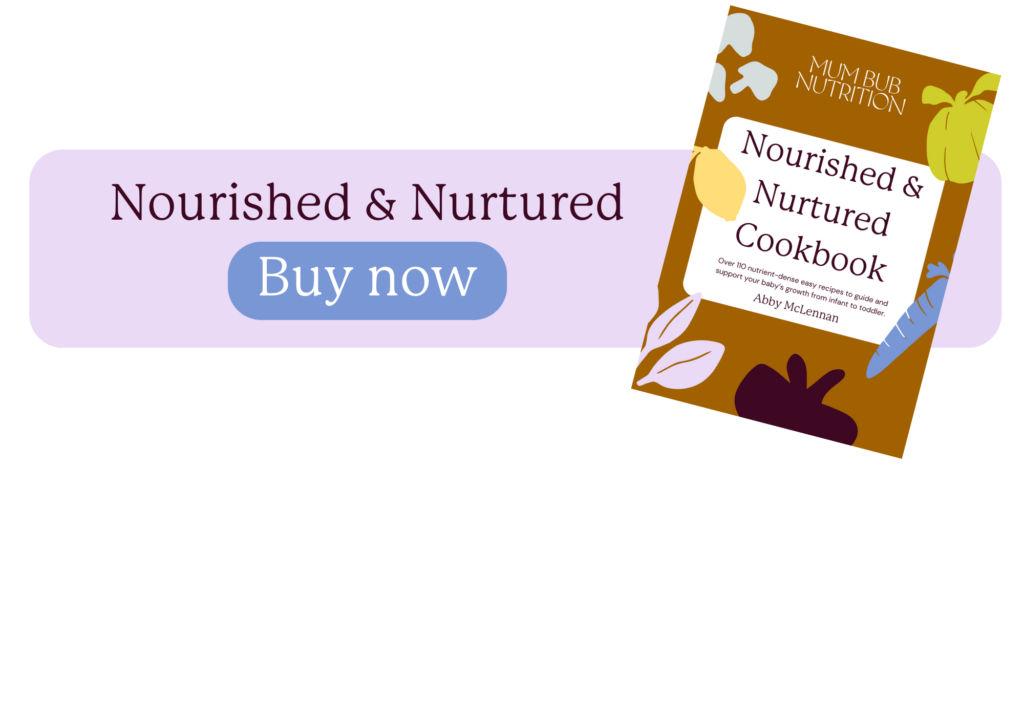
Making Sense of Baby Food Pouches: Honest Advice for Starting Solids

I want to start by saying baby food pouches are totally fine to use every once in a while. They’re not inherently bad, and they can absolutely be part of your baby’s diet now and then.
There’s been a lot of discussion recently, both internationally and in Australia, about the role of baby food pouches in starting solids. This article is here to give you up-to-date, evidence-based advice about baby food pouches without making you feel like a bad parent.
Honestly, starting solids can feel overwhelming enough. Whether you’re working full time or juggling life at home with a baby, you’re already doing an amazing job. And let’s be real, being a modern parent comes with so much conflicting advice! This isn’t about guilt. It’s about understanding where baby food pouches fit into your starting solids journey and how to use them in a way that works best for your bub if you choose to use them.
Why Baby Food Pouches Are Low in Iron, Zinc and Fat
When you’re starting solids, iron, zinc and healthy fats (mono and polyunsaturated) are essential nutrients your baby needs for growth, brain development and a strong immune system. Baby food pouches, especially fruit-based ones, are often very low in these key nutrients. Even savoury options sometimes have just a small amount of meat, usually between 5 and 10 percent of actual meat or iron-rich protein, blended with fruit to make them sweeter.
While baby food pouches are handy, they don’t provide the same nutrition as iron-rich whole foods like red meat, fish, beans, lentils, nuts, seeds and eggs. These whole foods are key for your baby’s health and also provide extra nutrients like B12, selenium and calcium, which are important for growth and development.
Understanding Pouch Ingredients: Why Fillers Are So Common
The ingredients in baby food pouches can be really confusing. Take a pouch that says “blueberries, banana and apple” on the front. You’d assume the ingredients are listed in that order. But when you flip it over, you might find the real breakdown is apple (60%), banana (25%) and blueberries (15%). Many fruit or veggie pouches are mostly apple, pear, carrot or pumpkin because these are cheap fillers.
Brands often highlight the most appealing ingredient on the front, but it’s usually present in the smallest amount. If a pouch contains protein like beef or chicken, that’s usually the main source of iron in the pouch, but it can be as low as 5% of the total.
If baby food pouches are used regularly as meals, it’s worth keeping in mind that while they’re convenient, they often fall short nutritionally.
High Sugar Content in Puree Pouches: What Parents Should Know
Another concern with food pouch purees is the sugar content. Even if baby food pouches say “no added sugar,” many still contain high amounts of natural sugars from fruit purees and concentrates. When fruit is pureed and processed, the sugars act like free sugars in the body.
How Free Sugars Impact Your Baby’s Health
Free sugars include sugars that are added to foods (like table sugar or honey) plus sugars naturally found in fruit juices, purees and concentrates. Even if a pouch is made from fruit, once the fruit is pureed, its sugars behave like added sugars in the body.
Unlike whole fruits, where sugar is locked in by fibre, free sugars are absorbed quickly. This can spike blood sugar and also increase the risk of tooth decay. The World Health Organisation recommends keeping free sugars to less than 10% of total energy, or ideally under 5% for extra health benefits. For babies under one, no free sugars are recommended at all. For children aged 1 to 3, that’s a maximum of around 2.5 teaspoons of free sugars per day.
Relying too often on puree pouches during starting solids can encourage a preference for sweeter foods and raise the risk of dental problems later on.
Same Texture for All Ages: How Food Pouch Purees Can Delay Skills
Starting solids isn’t just about nutrients. It’s also about learning to eat. Many baby food pouches have a smooth, uniform puree texture, no matter what age they’re sold for. This can slow down your baby’s progress with biting, chewing and exploring new textures.
Your baby needs exposure to a variety of textures like mashed, lumpy and finger foods to build their oral skills. Overusing baby pouches can delay these milestones because the smooth purees don’t challenge babies to develop chewing skills. The purpose of transitioning to different textures is to build familiarity and confidence to manipulate more challenging textures that are naturally present in wholefoods.
That lumpy texture stage should be introduced by 9 months at a minimum. Honestly, I’d love to see pouch companies offer a proper textured puree option!
Starting Solids at 4 Months? The Truth Behind Baby Pouch Marketing
You’ve probably seen baby food pouches labelled “suitable from 4+ months.” This can be really confusing when both national and international guidelines recommend starting solids around 6 months, once your baby is ready and signs of readiness have been met.
Baby pouch marketing can pressure parents into starting solids before their baby is developmentally ready. But the key signs to look for are good head control, sitting upright with support and showing interest in food, not what the pouch label says.
Baby Food Pouches and Tooth Decay: How High Sugar Plays a Role
It’s not just about nutrition. Sugar in baby food pouches also impacts dental health. Even before your baby turns one, using puree pouches regularly can contribute to tooth decay.
Sucking sweet purees directly from a pouch allows sugar to coat the gums and teeth, feeding bacteria that cause cavities. If you use baby pouches, offer them at mealtimes only and follow up with water to help rinse your baby’s mouth.
Why Pouch Spouts Are Not Ideal for Starting Solids
The design of baby food pouches can also create issues. Sucking from a pouch spout doesn’t encourage your baby to chew or develop oral coordination skills.
It’s important for babies to see, touch and explore their food during starting solids. Using a spoon or offering finger foods helps build these skills. If you’re offering baby pouches, squeeze the food onto a spoon or into a bowl to let your baby practise real eating and use all of their senses. Again, would love to see baby food pouch companies write on the food pouch packs a “how to use” suggestion of serving puree on a spoon.

Labelling Issues: Why Snack Pouches Should Be Marked for 12+ Months
Many snack pouches, like custard and other baby snacks, are labelled for babies from 6 months. But developmentally and nutritionally, they’re only suitable for toddlers 12 months and older.
Granted, some foods that are marketed to babies under 12 months such as teething rusks, contain iron, however they remain as teethers and not to be offered as a snack. Teething rusks also support biting and chewing skills for mouth and jaw development. There is an ever increasing product line of puffs and wafers which are marketed as a snack and offer very little nutrition.
During the starting solids phase, babies should focus on whole, nutrient-rich foods instead of packaged snacks. Labels can be misleading, so it’s worth double-checking whether a pouch or other marketed “baby snacks” is really the best choice for your baby’s needs.
Practical Tips for Using Baby Food Pouches (and Drop the Guilt)
First up, please don’t stress. Feeding little ones is overwhelming at times, and baby food pouches can be a lifesaver when life is busy. Using them doesn’t make you a “bad parent”. It’s a practical way to keep things manageable.
Here’s how to get the best out of baby pouches:
- Choose pouches with higher veg and protein, not just fruit.
- Offer baby pouches alongside finger foods for texture exposure.
- Use them when needed but focus on regular family meals when you can.
- Keep moving forward with textures during starting solids.
- Get creative: spread puree pouches on toast, serve as a dip, stir into yoghurt or pair with pasta shapes.
And one last thing: avoid feeding straight from the pouch when you can. Pop it onto a spoon or into a bowl so your baby can see and engage with their food while practising self-feeding.
I hope this reassures you if you’re using baby food pouches and gives you practical ideas to make them work within your starting solids journey.
Final Thoughts: Balance Is Key
Please don’t push yourself past your limits trying to avoid food pouches if you don’t have the mental, physical or social resources. I want you to hear this from a paediatric nutritionist: it’s all about balance. You can still use pouches thoughtfully as part of a well-rounded approach.
The Food for Health Alliance is working to improve food labelling for baby and toddler foods to support better nutrition and clearer info for parents. You can check them out here.
Quick Puree Ideas for When You’re Stuck
If you’re out of ideas for quick purees, you are definitely not the only one to feel this. I get it. When you’re juggling a million things and your baby is hungry now, or you’re rushing out the door, baby food pouches feel like the easiest option.
But honestly, making your own purees doesn’t have to be tricky or time-consuming. I’ve got loads of quick, cost-effective puree combos you can throw together using pantry staples and a few fresh bits. These are packed with key nutrients like iron and healthy fats.
I’ve put together 10 simple, iron-rich puree recipes that are full of flavour and take just 5 minutes to make. No fancy ingredients, no stress. Just easy, nourishing ideas.
You can check out the full list of recipes over on my blog here.
If you’re looking for more in-depth support to feel confident with starting solids plus heaps of easy, family-friendly recipes check out my eBook Nourished & Nurtured. Over 110 family recipes, purees and finger foods including quick recipes using iron rich cupboard staples.
References:
1. World Health Organisationhttps://www.who.int/publications/i/item/9789241549028
